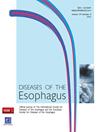222.机器人辅助食管切除术的长期生存率及其在治疗 CT4b 食管癌中的作用
IF 2.3
3区 医学
Q3 GASTROENTEROLOGY & HEPATOLOGY
引用次数: 0
摘要
(背景)机器人辅助食管切除术(RAMIE)获得保险批准后,最近已被引入许多医院。然而,RAMIE的长期疗效或其在治疗cT3br-T4食管癌中的作用仍不明确。(方法)本研究共选取了188例在2017年至2022年间接受RAMIE治疗的食管癌患者。其中,对20例cT3br-T4病例进行了回顾性研究,以评估短期疗效。同时,对随访2年及更长时间的RAMIE组(n=66)和VATS组(n=277)进行比较,以评估其长期疗效。(结果)背景因素:年龄=71(42-86),性别(男/女)=145/43,肿瘤位置(Ut/Mt/Lt,Ae)=25/84/79,cT1/2/3/4=36/31/101/20,cN0/1/2/3=65/82/34/7,cM0/1=155/33,术前治疗(无/化疗/CRT/两者)=39/139/10。手术结果;手术时间=508(273-833)分钟,控制台时间=244(108-479)分钟,估计失血量=130(0-2090)毫升,术后总发病率(CD分类≧2级)=53.2%(肺炎=29.3%,肺不张=9.0%,喉返神经麻痹=10.1%,手术部位感染=5.9%,乳糜胸=5.9%,吻合口漏=5.9%)。术后住院时间为 21(12-385)天。引入术中连续神经监测(NIM)后,喉返神经麻痹率从9.1%降至0.7%。就cT3br-T4病例(20例)的RAMIE而言,没有观察到转为开放手术或术中并发症,所有病例都实现了R0切除。RAMIE 组(66 例)与 VATS 组(277 例)的生存率比较显示,无病生存率和总生存率分别为 74.8% vs 70.9% (P=0.4582)、76.4% vs 78.5% (P=0.7626)。(结论)NIM 系统减少了 RAMIE 期间喉返神经的麻痹,而两组患者的生存率相当。鉴于其优势,RAMIE似乎特别适用于治疗cT3br-T4病例。我们还将在会上展示 cT3br-T4 病例的手术视频。本文章由计算机程序翻译,如有差异,请以英文原文为准。
222. LONG-TERM SURVIVAL OF ROBOT-ASSISTED ESOPHAGECTOMY AND ITS UTILITY IN TREATING CT4B ESOPHAGEAL CANCER
(Background) Robot-assisted esophagectomy (RAMIE) has lately been introduced to many hospitals after its insurance approval. However, long-term outcome of RAMIE or its utility in treating cT3br-T4 esophageal cancer remains unclear. (Methods) A total of 188 esophageal cancer patients who underwent RAMIE between 2017 and 2022 were eligible in the present study. Among them, 20 cases with cT3br-T4 were reviewed to evaluate short-term outcome. Also, a comparison between RAMIE (n=66) and VATS (n=277) group with 2-year and longer follow-up time was made to evaluate their long-term outcomes. (Results) Background factors; age=71 (42-86), gender (M/F)= 145/43, tumor location (Ut/Mt/Lt, Ae)= 25/84/79, cT1/2/3/4= 36/31/101/20, cN0/1/2/3= 65/82/34/7, cM0/1= 155/33, and preoperative treatment (none/chemo/CRT/both)= 39/139/10. Surgical outcomes; operation time = 508 (273-833) min, console time=244 (108-479) min, estimated blood loss= 130 (0-2090) ml, overall postoperative morbidity (CD classification≧grade2) = 53.2% (pneumonia= 29.3%, atelectasis=9.0%, palsy of recurrent laryngeal nerve=10.1%, surgical site infection=5.9%, chylothorax=5.9%, and anastomotic leakage=5.9%). Postoperative hospital stay was 21 (12-385) days. The palsy rate of recurrent laryngeal nerve decreased from 9.1 to 0.7% after introducing intraoperative continuous nerve monitoring (NIM). In terms of RAMIE for cT3br-T4 cases (n=20), no convert to open or intraoperative complications were observed while all cases achieved R0 resection. Regarding survival comparison between the RAMIE (n=66) and the VATS (n=277) group, disease-free and overall survival were 74.8 vs 70.9% (P=0.4582), 76.4 vs 78.5% (p=0.7626), respectively. (Conclusion) NIM system reduced the palsy of recurrent laryngeal nerve during RAMIE while the comparable survival was identified between the two groups. Given its advantage, RAMIE seems to be particularly useful in treating cT3br-T4 cases. Our surgical videos of cT3br-T4 cases will be also presented in the meeting.
求助全文
通过发布文献求助,成功后即可免费获取论文全文。
去求助
来源期刊

Diseases of the Esophagus
医学-胃肠肝病学
CiteScore
5.30
自引率
7.70%
发文量
568
审稿时长
6 months
期刊介绍:
Diseases of the Esophagus covers all aspects of the esophagus - etiology, investigation and diagnosis, and both medical and surgical treatment.
 求助内容:
求助内容: 应助结果提醒方式:
应助结果提醒方式:


